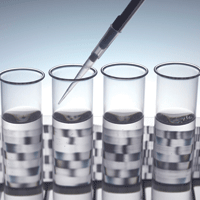During the past 20 years, advances in hemophilia treatment, including recombinant factor therapy, have allowed people with hemophilia to take greater control of their disorder. While the goal of safe and effective treatment through DNA technology has been realized, there is still much to be done to improve knowledge about the connection between the genetic cause of hemophilia and its management.
At the National Hemophilia Foundation’s (NHF’s) 64th Annual Meeting in November 2012 in Orlando, Val D. Bias, CEO, announced the launch of My Life, Our Future, a program that will help people with hemophilia and their families understand the unique aspects of their bleeding disorders by offering them free or low-cost genetic testing, also known as genotyping. The initiative is the result of a partnership between NHF, the American Thrombosis and Hemostasis Network (ATHN), the Puget Sound Blood Center (PSBC) and Biogen Idec Hemophilia. Genotyping may provide individuals and their physicians with insight into bleeding severity, inhibitor risk and carrier status, which can help improve their knowledge of the disorder and their care. It will also generate data that may advance scientific research on hemophilia and potentially lead to new treatments in the future.
What Is Genotyping?
Genotyping is the process of identifying the specific genetic mutation responsible for an individual’s disorder, in this case, hemophilia. “DNA is extracted from the blood to determine the factor VIII or IX sequence,” says Barbara Konkle, MD, medical director for the Hemostasis Reference Laboratory, and director of clinical and translational research at PSBC. “This is then compared to normal factor VIII or IX sequence to identify the specific mutation.”
Because of the large number of mutations associated with the disorder, genotyping is especially valuable in hemophilia. “There are more than 2,500 identified mutations for hemophilia A and more than 1,000 for hemophilia B. This is in contrast to many other genetic disorders where one mutation is always responsible,” says Marion Koerper, MD, medical advisor to NHF. Genotyping can identify the specific genetic mutation causing hemophilia in up to 98% of individuals who have hemophilia A and more than 99% of individuals who have hemophilia B.
The Benefit to Patients
One of the many benefits of genotyping for hemophilia is its potential to predict inhibitor risk. Extensive research has already suggested that certain mutations are associated with higher risk for inhibitor formation. For example, in severe hemophilia A, individuals with inversion mutations or large deletions may have a higher risk of developing an inhibitor. Genotyping may also provide information about bleeding severity, which varies widely even among individuals with the same type of hemophilia. Identifying patients’ genotypes may help physicians individualize treatment plans for them in the future. “If physicians can better understand someone’s bleeding pattern or inhibitor risk, they can modify the therapy and care in an effort to provide the best outcome for the patient,” says Konkle.

StockbrokerXtra/Glow Images
Moreover, these tests can also identify carriers, aid in early family planning, and possibly improve outcomes during childbirth and after delivery. “If a woman knows she is going to have a child with hemophilia, she and her family can better prepare for delivery and care,” says Bias, who has hemophilia B and has been genotyped. He notes that genotyping has been a valuable tool for his extended family. The women in his family were genotyped when considering pregnancy. Genotyping has allowed them to embrace their family’s bleeding disorder, Bias says.
Addressing a Long-Unmet Need
Despite the benefits of genotyping, a survey of healthcare providers conducted by ATHN in October 2012 shows that only 20% of people with hemophilia in the US have been genotyped. The majority of respondents cited the cost of testing and insurance coverage restrictions as the main barriers. But the community’s interest in genotyping is high. In a 2012 survey of more than 1,000 hemophilia community members conducted by NHF, more than 75% said they would take advantage of free or low-cost genotyping if it were available. My Life, Our Future addresses this obstacle and will eventually enable most people with hemophilia in the US to be genotyped at no or very low cost.
“For the past 15 years, we in the hemophilia community have been advocating for widespread access to genotyping for patients and carriers, but until now, the combination of resources and expertise was not available,” says Glenn Pierce, MD, PhD, senior vice president, global medical affairs for Biogen Idec and chief medical officer of Biogen Idec Hemophilia. As a two-time past president of NHF’s board of directors, Pierce remembers when NHF’s Medical and Scientific Advisory Council (MASAC) passed a resolution in 1999 recommending genotyping as part of comprehensive care for individuals with inherited bleeding disorders. MASAC also recommended that NHF identify funding sources to make the service widely available. In 2003, a resolution was introduced in Congress to increase funding for research for bleeding disorders and facilitate genotyping, but it was not enacted. In 2005, the Centers for Disease Control and Prevention provided access to genotyping to a subset of patients as part of a study of inhibitors, but was unable to offer a national genotyping program due to logistical and funding challenges.
My Life, Our Future has been made possible through the collaboration of four leaders in the hemophilia community, each of which plays a crucial role in the program. ATHN, a not-for-profit organization representing more than 130 hemophilia treatment centers (HTCs), is ensuring the collection and secure storage of data and preparing HTCs to implement the service. NHF is educating patients and the community about the program through its chapter network and resources. PSBC, a state-of-the-art laboratory and research institution with expertise in hemophilia mutation analysis, is conducting the secure genetic testing and analysis. Biogen Idec Hemophilia, a biotechnology company committed to empowering people with hemophilia, is providing funding and scientific expertise for the partnership through at least 2014. Thereafter, the project may be extended to provide greater access to those affected by hemophilia. In November 2012, MASAC adopted a recommendation that all individuals with hemophilia and their affected family members participate in My Life, Our Future.
My Life, Our Future: How It Works
The goal of My Life, Our Future is to genotype as many people in the US affected by hemophilia as possible. To ensure a smooth national rollout, the program is being piloted in spring 2013 in at least 10 HTCs that will offer free or very-low-cost genotyping to existing patients.
Once the results from the pilot sites have been reviewed and any needed adjustments made, the genotyping service will be expanded to other HTCs across the country. Plans are to eventually expand the service to potential carriers.

Science Photo Library/Glow Images
During the pilot phase and after, individuals with hemophilia A or B who want to access the genotyping service will only need to visit their participating HTC for a blood test. The HTC will send the blood sample to PSBC’s specialized hemophilia laboratory for genetic analysis. PSBC will then send a clinical report summarizing the test results to the HTC where the test was done. The patient’s treating physician will then share the screening test results privately with his or her patient. This report will be stored in the individual’s HTC record and in PSBC’s secure laboratory information system. The clinical report will not be shared with insurers, employers or other parties. It will be up to patients whether they want to share the report with others, including family members. The program will adhere to best practices, and all state and federal laws designed to protect the privacy of patients, including the Health Insurance Portability and Accountability Act (HIPAA) and the 2008 Genetic Information Nondiscrimination Act (GINA).
Furthering Scientific Research for Future Generations
In addition to receiving results that could improve the management of their hemophilia, participants will have the option to simultaneously support scientific research by making their de-identified genetic data and samples available to researchers. At the time of the test, patients will be asked to provide consent to allow their data to be entered into the ATHNdataset, a secure community resource that is now supported by more than 130 HTCs. Patients can also consent to have their blood sample and DNA stored in a research repository at PSBC. MASAC recommends that individuals “strongly consider agreeing to have their de-identified mutation results added to the ATHNdataset” to further research and scientific understanding of the relationships between genotypes and clinical characteristics, called phenotypes.
In the future, scientists and researchers at academic institutions or drug discovery companies may apply for access to the data or samples through ATHN to support scientifically sound research projects. ATHN’s review committee will screen these applications to determine the feasibility and scientific validity of each project. No organization, including Biogen Idec Hemophilia, will be given preferential access to the data.
Further, neither ATHN nor researchers will ever have access to patient names or any other information that could be used to identify an individual, or his or her family. “The patient’s identity will remain strictly confidential. Data and samples will be labeled only with a code number,” says Diane Aschman, MS, president and CEO of ATHN.
Although individuals who do not wish to contribute their data or samples for research can still be genotyped, the hope is that most patients will consent to their data and blood sample storage, knowing it could help future generations of people with hemophilia. A list of approved research projects and the studies conducted using the research will be made available to the public.
“This is an opportunity to pool the unique information that each of us possesses to advance the scientific understanding of hemophilia,” Bias says.
Information for this article was provided by the National Hemophilia Foundation, the American Thrombosis and Hemostasis Network, the Puget Sound Blood Center and Biogen Idec Hemophilia.

